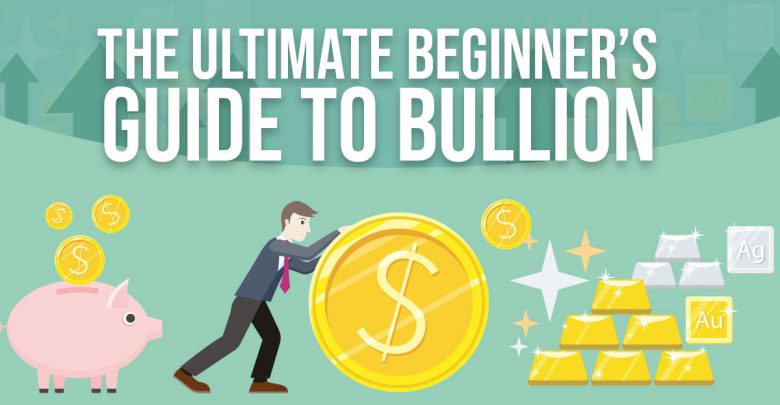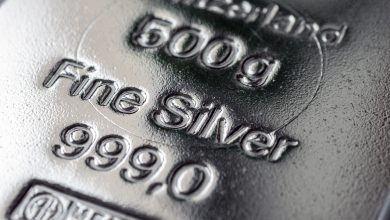The Ultimate Beginner’s Guide to Bullion
For all questions bullion related, look no further.

New to bullion? As you’ve probably discovered it can be confusing at first – new words, new concepts, a whole range of products from physical bullion to bullion storage and self-managed super funds. In light of the knowledge that the biggest economic crisis to date is headed our way, you’re likely looking for a low-risk and stable form of investment to protect yourself and loved ones should the worst occur. Or maybe you’re just looking for some diversity within your current investments.
No worries, we understand and that’s why we’ve put this helpful guide together to take you through the ins and outs of bullion, from choosing the right product for you, to investing, buying, selling or bullion storage options.
What is Bullion?
Let’s start with the basics. What does ‘bullion’ actually mean?
The word ‘bullion’ originates from the term ‘bouillon’ which means ‘coin mint’ in French. Bullion commonly refers to investment grade precious metals that are traded based on the current metal price. Precious metals commonly include gold, silver, palladium and platinum and are usually traded in bar or coin form.
Bullion is not really used as direct payment but it is highly liquid, meaning it can quickly and easily be converted to cash almost anywhere in the world!
Why Invest in Bullion?
Now that you know what bullion is, you might be wondering what people do with it? Well, they invest in it. Any smart investor would have a place for bullion in their investment portfolio as it helps – particularly investing in gold bullion – to protect against global economic catastrophes and guard against inflation and deflation. Bullion is best considered as a long-term investment.
Here are 7 reasons why you should to invest in bullion:
- Every other form of currency has failed:

- Portfolio Diversification
When it comes to other commodities and the stock market, bullion tends to march to the beat of its own drum. What we mean by this is that typically when other investments are falling, gold tends to rise in value, helping to hedge against potential losses. As a result, owning bullion is a great way to diversify your investment portfolio – any smart investor would think so too!
The chart below shows the performance of gold’s return over time when compared to key asset classes:

- It maintains its purchasing power over time
Gold has maintained its value throughout the ages, particularly when compared to paper currency. You’ve probably heard the quote “with an ounce of gold a man could buy a fine suit of clothes in the time of Shakespeare, in that of Beethoven and Jefferson, in the Depression of the 1930s.” In today’s economy, an ounce of gold could still buy you a decent suit, but to compare, $1 of currency buys you significantly less today than it did 40 years ago. This shows gold’s purchasing power remains stable unlike currency.
Of course it’s a little more complex than that. As you can see in the graph below, gold’s purchasing power can vary over time. Looking at gold’s purchasing power in 2016, you can see the value is higher than that of almost 50 years ago in 1968. Although gold rises and falls along the way, gold’s purchasing power overall is very stable, particularly over long periods of time.

- Appreciation over time
Bullion is not the type of investment that has quick bursts of growth that you can trade and sell like the stock market. Instead, bullion is best considered as a long term strategy and that’s where you’ll really see your return on investment. In fact, since the year 2000, gold was priced around US$272 per ounce and is currently at US$1300 in April 2019. That’s a pretty decent return.
- Current state of the global economy and protection against major economic crisis:
One of the most commonly searched questions relating to bullion is whether or not it is a good investment in today’s economy. From our perspective, it’s a big, fat, YES. It’s no secret that a major economic crisis is on the way – thank you global debt – and the economy is starting to show some serious cracks. The current state of the economy is at a position that we’ve never seen before. We’ve got budget deficits, trade deficits and government debt at insane levels. Similarly, we’ve also got lethal bubbles in real estate, stocks, credit, debit and derivatives, and as history has shown all bubbles all burst! One thing that remains true is that is that in times of crisis such as recessions or economic slowdowns, gold and silver bullion have historically always out performed all other investments.
- Currency hedging against the Australian Dollar
As mentioned, bullion (particularly gold) is a great hedge against investments in other commodities and the stock market. But for Australians in particular, it is also a great currency hedge. Historically, whenever the Australian Dollar has fallen, the price of gold had risen.
- Strong performance during periods of high inflation
Linking to back to the first point in this list, as the central banks continue to print money, the risk of inflation increases. Here, gold kills two birds with one stone. The first, gold is a great hedge against currency devaluation, and the second, gold performs well during periods of high inflation. This makes gold a great way to protect wealth against economic risks
How to Invest in bullion
When it comes to investing in bullion, your aim is to buy when prices are low and sell when prices are high (just like any other investments). As mentioned, it is good to keep in mind that bullion is best considered as a long term strategy that grows in wealth over time, with its primary function as a secure hedge against other investments.
When it comes to bullion, the markets are often hard to predict and it can involve a lot of time keeping up with the latest bullion news and predictions. Knowing where to start and the most reliable places to source your information from can be difficult too.
Frequent questions from first time investors are always about how to start buying gold and what the minimum investment is. The answer depends on you and the reasons why you’re buying gold. Many people that are concerned with the economy collapsing prefer to buy gold in smaller physical sizes such as 1/4oz, 5g or 10g pieces, which are easier to barter with should the worst occur.
Buying gold or other precious metals in smaller physical sizes, does mean that you will be paying a higher premium per ounce or gram. Therefore, if you’re buying gold for investment purposes, we recommend buying 1oz – 100g bars to get the best value for money, while also ensuring you have a product that’s easy to trade. While premiums are reduced the larger the physical size of the gold bar you buy – e.g. buying a 1kg bar will get you a cheaper price per ounce/gram – on the flip side it will be harder to sell. For first timers you’re looking at a minimum starting investment of just under AUD$2000 for a 1oz gold bar (at the time of writing).
Once you’ve decided on how much you’d like to invest, you need to find a reputable bullion dealer. Local is best if you’re looking for competitive prices or to buy in store at a showroom, but you can also buy online and over the phone with most reputable bullion dealers.
Of course, we’re going to be biased here and suggest KJC Coins Australia as your reputable choice, but in case you need a little more convincing here’s a list of the reputable reasons to buy with KJC. Unlike other bullion dealers in the market, KJC is a fully independent and private company which means we have no restrictions on our products lines or prices. As a result, we’re able to stock Australia’s most extensive selection of internationally accredited bars and bullion coins from refiners such as Credit Suisse, Valcambi, PAMP, Royal Canadian Mint and the Perth Mint. We also have stock from the world’s most renowned government mints including Chinese Pandas, American Eagles, Canadian Maples and much more, all at extremely competitive prices.
We guarantee quality and authentic products every time you purchase. For instance, many bullion dealers can’t tell when a gold coin is fake or real, but KJC has been established since 1995 and our company directors have over 50 years combined industry experience in bullion and numismatics old and new. We know which gold coins and bars are legitimate and which are counterfeits.
A great bullion dealer will proudly display their reputable qualities on their website and you should look for these when choosing which one to go with. It is also a good idea to check that they stock products from well-known brands, refiners and government mints.
Next, all that’s left to do is buy. As mentioned, most bullion dealers, like KJC, allow you to buy in person in the showroom, over the phone or online – KJC’s online store for example is live to market and available 24/7, 365 days a year. If your investment is under $5000, the purchase process is simple; choose a product, pay for it, receive the product. If however, your investment is over $5000, it is required by law that you provide appropriate levels of identification before your purchase is able to be shipped or collected.
What Bullion Products should I invest in?
Your first decision is which metal to invest in. The most common metals are Gold, Silver, Palladium and Platinum, but at KJC we also offer Rhodium and just a heads up Rhodium is looking like a pretty great investment at the moment.
While the demand for all metals is strong, gold’s appeal is that it is a safe and stable investment that performs particularly well during economic depressions and recessions. It is a monetary metal that’s highly liquid, the easiest to buy and sell and is transportable.
Silver’s appeal is that it’s much cheaper than gold but has the highest industrial demand. It is a lot heavier than gold, but has the biggest potential for increased percentage gained. It’s also incredibly cheap at the moment!
For more serious investors, you can look at investing in platinum, palladium or rhodium. Platinum, like gold and silver is considered a precious metal under Australia’s GST act, meaning you don’t have to pay GST on them (unless their purity is less than 999%). When buying rhodium or palladium however, you will need to pay GST. It’s also important to note that platinum, palladium and rhodium can be affected more-so by the economy than gold and silver, but they can also be a value play. Rhodium for example is an extremely rare metal and platinum is relatively cheap at the moment.
Bullion Bars, Bullion Coins & Rare Coins
Once you’ve selected the metal you want to invest in, the next thing to consider is the type of product. Bullion typically comes in bars (either in bar or ingot form), coins and rounds. But how do you know which to buy?
A lot of the answer depends on your answers to the following questions:
- Do you want to sell the gold you buy all at once or in smaller parts?
For example, if you buy a 1kg bar, when it comes to selling the gold, you will have to sell the whole bar and won’t be able to sell just a portion of it. There is often less of a market for larger bullion products because of their inability to be broken up and sold in smaller portions.
- What will the demand be?
For example, bars with well known and internationally recognised brands can be easier to sell than locally branded bars or branded bars that are not well known. Bullion coins have added advantages because they are considered legal tender that is backed and recognised by the government. This makes it the ultimate form of liquidity because they will be recognised anywhere in the world, and are therefore easier to sell.
Bullion Bars:
Bullion bars come in two different types:
- Cast Bars: A very simple and sometimes rugged bar with the brand, weight and percentage of purity. While gold is more likely to have a balance between cast bars and minted bars, silver bars are more common in cast bar form.
- Minted bars: A highly detailed bar sometimes with a design. The brand, weight and percentage of purity will also feature on it. They may be more expensive than cast bars, but not in all cases.
So which do you choose? When buying bars, you want to make sure that you always check the purity of the bar. For example, when buying gold, you want to make sure you buy with a purity of 99.99% and with silver or platinum, you want to the purity to be at minimum, 99.9%. Regardless of if the bar is a cast bar or a mint bar, if both have a purity of 99.99%, the purity of the precious metal will be the same in both. The only difference between the two will be that the minted bar looks a bit nicer.
In the end it comes down to personal preference. Minted bars are usually packaged and need to be kept packaged in order to keep their value. They are also aesthetically more attractive. However some people like to be able to hold their bar physically in their hand, in which case a cast bar would be the better choice.
Bullion Coins:
Like bars, bullion coins can come in a variety of different weights. Pricing can differ depending on designs and mintage, both of which can increase the value of the coin. On a bullion coin you can find their face value, year of production, weight and purity. Bullion coins are available in gold, silver, platinum and palladium and come with unique designs based on the country it’s from. Coins more importantly, are government issued legal tender and are therefore more easily recognised and easier to sell.
Bullion Rounds:
Rounds are similar to coins but do not have any legal tender. They have different designs and are generally cheaper than bullion coins. You’ll find the pricing of rounds more inline with bullion bars.
Paper Gold VS. Physical Bullion
As a bullion dealer, KJC always recommends the purchase of physical bullion products, but there are other ways you can also purchase gold such as exchange-traded funds (ETFs). Purchasing an ETF is basically like buying shares in gold – so you don’t actually own any physical gold or even know if what you bought actually exists. In some cases this can mean some very risky business especially if counter parties file for bankruptcy.
Where to buy authentic bullion?
You can buy authentic bullion from a reputable bullion dealer, but if you’re a new investor it can be hard to tell the difference between who is reputable and who isn’t. Here are some things to look out for when it comes to buying from an authentic bullion dealer.
- Check that the company or dealer has been in the business for a long time. KJC has been established since 1995 and our company directors have over 50 years combined industry experience in bullion and numismatics old and new. We guarantee only quality and authentic products. Our experience means we can tell when a bullion bar or coin is counterfeit, which many bullion dealers do not have experience in.
- Check where a bullion dealer sources their products from. Are they from recognisable refiners or government mints? For example KJC stocks a range of products from LBMA bullion market association (London Bullion Market Association) accredited refiners such as Valcambi, Elemental, Credit Suisse and The Perth Mint as well as other government mints.
- Avoid purchasing from ‘no name’ eBay stores. We often get customers that come in with packaged bars they have purchased on eBay only to have to turn them away because they aren’t real gold.
- A reputable bullion company will have a physical and online presence where you can buy and sell products from.
- Make sure the bullion dealer or company has sound education on bullion products. Do they have an information rich blog or website and can they answer all your questions – whether in person, over the phone, or online – in great detail?
At KJC you can rest assured that we are a well established, internationally recognised bullion dealer with strong financial backing.
What are your options for storing bullion?
Ok, so you’ve bought your gold, silver or precious metals, the next question is where do you store it? Storing your bullion is important because not only do you need to store it somewhere safe and secure, it also needs to be properly protected from damage. Here are some different ways you can store your bullion:
- At home
- Safety deposit boxes with the bank
- Storage with a bullion dealer – like KJC Coins Australia
It will come to no surprise that the first two options; storying your bullion at home or in a safety deposit box with the bank, do not come with any insurance and will therefore need to be covered under household insurance. This can be difficult to find and expensive depending on the amount of bullion you own.
If you’ve accumulated a significant sum of bullion, it’s in your best interest to consider external storage for safety, insurance and ease of selling. When looking for an external storage provider, make sure you do your research. With most storage companies, it is likely that you will only be provided insurance up to a limit and this limit may not cover you fully. If you find this is the case, it can be both costly and difficult to find a full cover solution. Similarly storage companies often hold no responsibility if something goes wrong and the onus is on YOU to provide proof of what you have stored – this may mean constant documentation, photographs and third party witnesses.
KJC’s Secure Vaulting service works differently. We offer a premium, fully allocated storage solution for majority of products on our website and all bullion stored with us is insured at full replacement value.
We use the LBMA recognised Sydney vaulting facilities of G4S and all items stored are audited with records backed by multiple third parties for your convenience. You also have the option to store your bullion in secure boxes so you get back the exact pieces of gold that you bought. This can be great for those with Self Managed Superfunds or for those who intend to store their gold for long periods of time without needing to access it. With this system we give you peace of mind without the hassle of needing to audit and keep documentation of your wealth. We also believe that KJC’s Secure Vaulting is the only Australian storage service to offer PPSA Protection for total peace of mind. Our PPSA Protection covers the gap in Australian law that allows receivers appointed to a storage company that goes into liquidation, the right to take all the goods held by the storage company regardless of who they belong to.
With KJC Secure Vaulting, your bullion is able to be immediately transported to all major hubs across the globe, providing ultimate portability – a huge advantage in today’s marketplace. Selling is also simple and immediate – all you need to do is tell us by phone or email. No transport is required and there’s no security risk. Payment is quick and easy to your bank account. What more could you want?
How to Sell your Bullion
After you’ve bought your bullion, the next thing you’re going to want to know is when should you sell it and how can you get the best price for it.
First of all, you need to understand a little about the process of selling and buying bullion. A common misunderstanding is that you’ll be selling and buying your bullion at the current spot price but it doesn’t work that way. When you buy bullion, you’ll be buying it for the spot price, plus a premium. When you sell, you’ll receive a little less than the current spot price. Why? Because bullion dealers and manufacturers need to make money too.
If you’re interested in how much money a bullion dealer makes from their premiums, you’ll find it’s not as much as you may think after costs are considered. It costs money for mints to melt and refine gold into a product, and to cover costs they therefore charge a premium on products they sell to their wholesalers. Dealers then purchase these products from wholesalers at a premium. Overall, dealers typically profit around 1-2% off a sale or purchase.
The best way to get the best price is to shop around at your local and reputable dealers to find a price you’re happy with. The good news is that bullion is highly liquid which makes it easy to sell in exchange for funds whenever you need. To ensure you get the best price when selling your gold, it is important that when you buy, you buy a bar or coin that has a recognisable brand and is from a reputable dealer. Buying an unrecognised bar can be tempting because while it may be cheaper, you run the risk of selling it for less, as bullion dealers themselves have a hard time selling unrecognised bars.
If you’ve registered your purchases with a bullion company, it is likely the place you bought it from will buy it back from you. At KJC, we buy back from clients and non-clients provided the bullion products are in tradable condition (undamaged) and are from well – known brands.
Still got questions? Leave a comment below and we’ll answer them as soon as possible!





